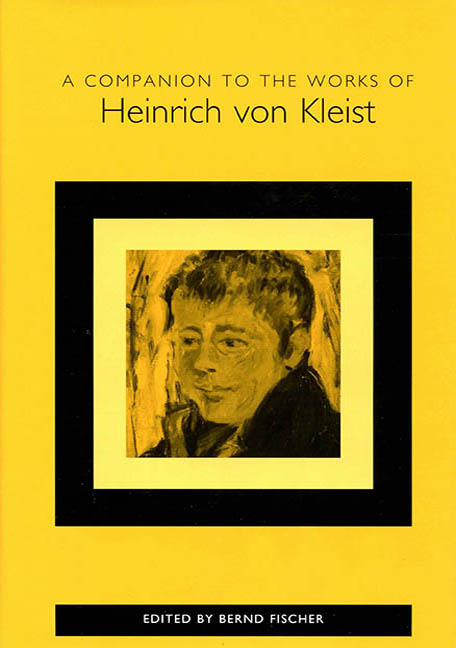Book contents
- Frontmatter
- Contents
- Introduction: Heinrich von Kleist's Life and Work
- Critical Approaches
- Language and Form
- On Structures in Kleist
- Strange News: Kleist's Novellas
- The Eye of the Beholder: Kleist's Visual Poetics of Knowledge
- The Performative Turn of the Beautiful: “Free Play” of Language and the “Unspeakable Person”
- Intellectual Paradigms
- Themes and Motifs
- Notes on the Contributors
- Index
The Eye of the Beholder: Kleist's Visual Poetics of Knowledge
from Language and Form
Published online by Cambridge University Press: 27 April 2017
- Frontmatter
- Contents
- Introduction: Heinrich von Kleist's Life and Work
- Critical Approaches
- Language and Form
- On Structures in Kleist
- Strange News: Kleist's Novellas
- The Eye of the Beholder: Kleist's Visual Poetics of Knowledge
- The Performative Turn of the Beautiful: “Free Play” of Language and the “Unspeakable Person”
- Intellectual Paradigms
- Themes and Motifs
- Notes on the Contributors
- Index
Summary
The imagery of the eye,” Fredric Jameson remarks in The Prison-House of Language, “has often seemed to furnish a privileged language for the description of epistemological disorders” (206). To prove his point in an argument for self-reflexive criticism, Jameson relates an episode by James Thurber in which a student of botany is told that if he does not properly adjust the microscope he will only see his own eye rather than what he is supposed to see. But what to the scientist seems a limitation, if not a failure, of perspective is a welcome analogy for postmodern critics to proclaim the loss of the referent to self-referential language; for the linguistic window to the world has become opaque, a screen onto which the image of the viewer/speaker is projected. Looking for truth outside, the metonymic eye ends up seeing only itself. Truth is in the eye of the beholder.
Heinrich von Kleist was obsessed with seeing and employed eye imagery to confront the perception of truth throughout his oeuvre, which spans only one decade — from 1801 to his suicide in 1811. Even those who are barely familiar with his work would immediately be able to connect, however vaguely, the famous ocular image of “green glasses” with Kleist's own version of an epistemological disorder, better known as the socalled Kant crisis. As the formulaic connection, which will be discussed later, obviously combined a poetic and an existential aspect, it was ideally suited for explaining why and how Kleist became a writer (cf. Seeba 1991) once the biographical approach to literature began to favor anecdotes about the deciding moment of poetic inspiration. Unlike the popular fantasies of inspiration about Schiller smelling rotten apples and Hofmannsthal's hand running through precious pearls, the Kant crisis served to place Kleist's muses, these dark forces of the abyss that lured him frequently to consider and eventually to commit suicide, in a broader existential context of Faustian dimension. For many critics the creative despair of an inadequate truth seeker was so good an image that they were disinclined to look beyond the biographical scintillation and explore in Kleist's oeuvre the literary manifestation of the paradigm shift from the mind to the eye, from the cognitive to the physiological aspect of perception.
- Type
- Chapter
- Information
- A Companion to the Works of Heinrich von Kleist , pp. 103 - 122Publisher: Boydell & BrewerPrint publication year: 2003



